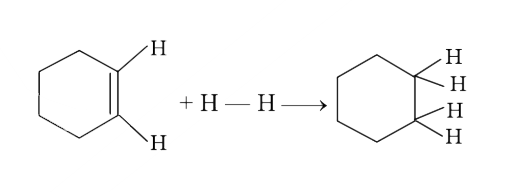For the reaction,

bond energies are given as under –
(i) C—C, 346 kJ/mol
(ii) C—H, 413 kJ/mol
(iii) H—H, 437 kJ/mol and
(iv) C = C, 611 kJ/mol
What will be the value of ΔH at 25∘C for the above reaction ?
−289kJmol−1
−124kJmol−1
+124kJmol−1
+289kJmol−1
The correct Answer is:B
Topper's Solved these Questions
- THERMOCHEMISTRY BOOK - MOTIONCHAPTER - THERMOCHEMISTRY EXERCISE - Exercise - 2 (Level-II)
29 Videos
- THERMOCHEMISTRY BOOK - MOTIONCHAPTER - THERMOCHEMISTRY EXERCISE - Exercise - 3
50 Videos
- THERMOCHEMISTRY BOOK - MOTIONCHAPTER - THERMOCHEMISTRY EXERCISE - EXERCISE -1 SECTION E
3 Videos
- SURFACE CHEMISTRYBOOK - MOTIONCHAPTER - SURFACE CHEMISTRYEXERCISE - Exercise - 3 (Level-II)
12 Videos
- THERMODYNAMICSBOOK - MOTIONCHAPTER - THERMODYNAMICSEXERCISE - EXERCISE - 4 (LEVEL - II)
19 Videos
Similar Questions
Given the bond energies of H−H and Cl−Cl are 430kJmol−1 and 240kJmol−1, respectively, and ΔfH∘ for HCl is −90kJmol−1. Bond enthalpy of HCl is
View SolutionHeat of combustion of gaseous isoprene (C5H8)
CH2=CH−C=C∣CH3H2 to CO2(g) & H2O(l) is -3186 kJ/mole .
Calculate the heat of formation and compare with bond energies. Calculate the resonance energy of isoprene.
Given :ΔfH(CO2,g)=−393.5 kJ/mol , ΔfH(H2O,l)=−285.84 kJ/mol
Bond energies of C−H,C−C & C = C are 413 , 348 and 615 kJ .
Heat of atomization of carbon and H2 are 718.4 and 435.8
View Solution
Knowledge Check
Bond energies of H−HandCl−Cl are 430 kJ mol−1 and 242 kJ mol−1 respectively. ΔHf for HCl is 91 kJ mol−1.
What will be the bond energy of H−Cl?A672 kJB182 kJC245 kJD88 kJBond energies of H−HandCl−Cl are 430 kJ mol−1 and 242 kJ mol−1 respectively. ΔHf for HCl is 91 kJ mol−1.
What will be the bond energy of H−Cl?A672 kJB182 kJC245 kJD88 kJGiven the bond energies of H−H and Cl−Cl are 430kJmol−1 and 240kJmol−1, respectively, and ΔfH∘ for HCl is −90kJmol−1. Bond enthalpy of HCl is
A245kJmol−1B290kJmol−1C380kJmol−1D425kJmol−1
If for a reaction ΔH=50kJmol,ΔS=50JK−mol then ΔG at 500K will be (A) 25kJ/mol (B) 5000kJ/mol (c) 0.5kJ/mol (D) 10000kJ/mol
View SolutionFollowing are the values of EaandΔH for three reactions carried out at the same temperature :
I:Ea=20kJmol−1,ΔH=−60kJmol−1
II:Ea=10kJmol−1,ΔH=−20kJmol−1
III:Ea=40kJmol−1,ΔH=+15kJmol−1
If all the three reaction have same frequency factor then fastest and slowest reactions are :
View SolutionGiven that the bond energies of H - H and CI - CI are 430kJmol−1 and 240kJmol−1 respectively and ΔfH for HCI is −90kJmol−1, bond enthalpy of HCI is
View SolutionGiven the bond energies of H−H and Cl−Cl are 430kJmol−1 and 240kJmol−1, respectively, and ΔfH∘ for HCl is −90kJmol−1. Bond enthalpy of HCl is
View SolutionThe bond energies of C-C,C=C, H-H and C-H bonds are 350 kJ mol−1, 600 kJmol−1, 400 kJmol−1 and 410 kJmol−1 respectively. The enthalpy of hydrogenation of ethane is _______________.
View Solution
